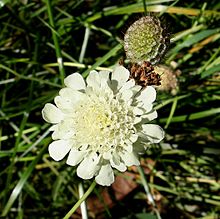
Knautia is a genus in the family Caprifoliaceae. The common names of these flowers are a variant of "widow flower." Others are given the name "Scabious," although this word belongs to a related genus (Scabiosa). The name Knautia comes from the 17th-century German botanists, Drs. Christoph and Christian Knaut.

Centaurea scabiosa or greater knapweed is a perennial plant of the genus Centaurea. It is native to Europe and bears purple flower heads.

Scabiosa caucasica, the Caucasian pincushion flower, pincushion-flower or Caucasian scabious, is a species of flowering plant in the family Caprifoliaceae, native to the Caucasus, north eastern Turkey, and northern Iran. Growing to 60 cm (24 in) tall and broad, it is a clump-forming perennial with divided leaves. Pincushion-shaped buds, borne on erect stems, open to pale blue or lavender flower heads, 8 cm (3 in) in diameter, from late summer through to autumn.

Scabiosa graminifolia, grass-leaved scabious is a species of scabious found in the Mediterranean region. The plant grows on rocky slopes. As its name indicates, this species has grass-like leaves. Its flowers are pink or lilac and open in summer.
Great Cheverell Hill is a 33.2 hectare biological Site of Special Scientific Interest at Great Cheverell in Wiltshire, notified in 1971.

Scabiosa atropurpurea, the mourningbride or sweet scabious, is an ornamental plant of genus Scabiosa in the family Caprifoliaceae.
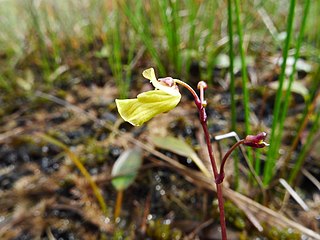
Utricularia ochroleuca, the yellowishwhite bladderwort, pale bladderwort, or cream-flowered bladderwort, is a small, perennial carnivorous plant that belongs to the genus Utricularia. It is usually found affixed to the substrate. U. ochroleuca is a circumboreal species and is found in North America, Asia, and Europe.
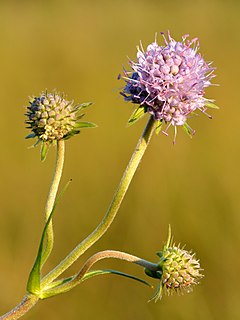
Succisa pratensis, also known as devil's-bit or devil's-bit scabious, is a flowering plant in the honeysuckle family Caprifoliaceae. It differs from other similar species in that it has four-lobed flowers, whereas small scabious and field scabious have five lobes and hence it has been placed in a separate genus in the same family. It also grows on damper ground.
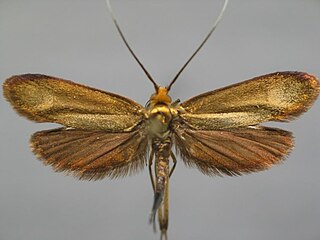
Nemophora metallica is a moth of the family Adelidae. It is found in Europe.

Fishburn Grassland is a Site of Special Scientific Interest in the Sedgefield district of County Durham, England. It lies between the villages of Fishburn and Trimdon, just north of the former.

Quarrington Hill Grasslands is a Site of Special Scientific Interest in County Durham, England. The site consists of three separate areas, two closely adjacent to the east of the village of Quarrington Hill, the third immediately west of the village, which lies 8 km south-east of Durham City.

Tuthill Quarry is a Site of Special Scientific Interest in the Easington district of north-east County Durham, England. It lies just over 1 km east of the village of Haswell.

The Bottoms is a Site of Special Scientific Interest in County Durham, England. It lies just south of the A181 road, roughly midway between the villages of Cassop and Wheatley Hill, some 10 km south-east of Durham city.
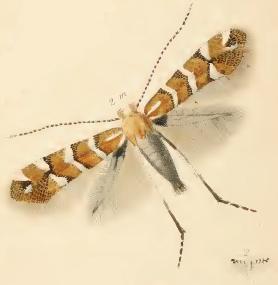
Phyllonorycter scabiosella is a moth of the family Gracillariidae. It is found from Great Britain through Germany, Poland and Ukraine to southern Russia and from the Netherlands to Spain and Italy.
Stenoptilia stigmatodactylus is a moth of the family Pterophoridae. It is found in western, central and Mediterranean Europe, extending into Asia Minor and North Africa. It is also known from Iran, Russia and Armenia.
Gillmeria miantodactylus is a moth of the family Pterophoridae. It is found in France, Austria, Hungary, Romania, Bulgaria, the Republic of Macedonia, Ukraine, Russia and Asia Minor.

Aethes hartmanniana, the scabious conch, is a moth of the family Tortricidae. It was described by Carl Alexander Clerck in 1759. It is found in most of Europe, Asia Minor, Armenia and the southern Urals. The species occurs in chalky and limestone habitats.

Abia sericea, common name Club Horned Sawfly or Scabious Sawfly, is a species of sawflies belonging to the family Cimbicidae.
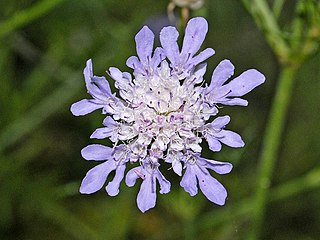
Scabiosa triandra is a species of scabious belonging to the family Caprifoliaceae.
